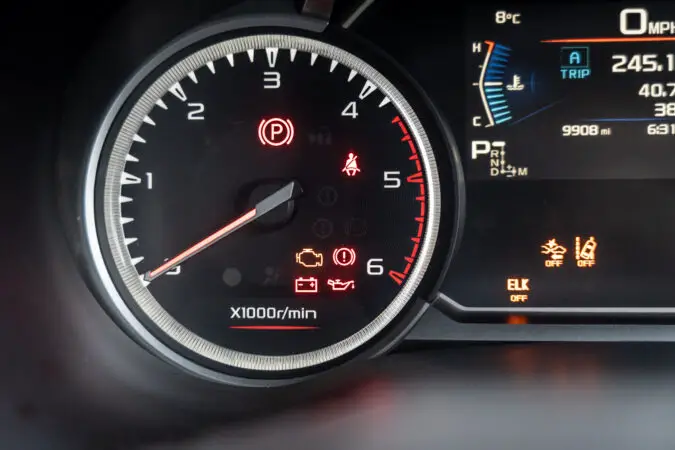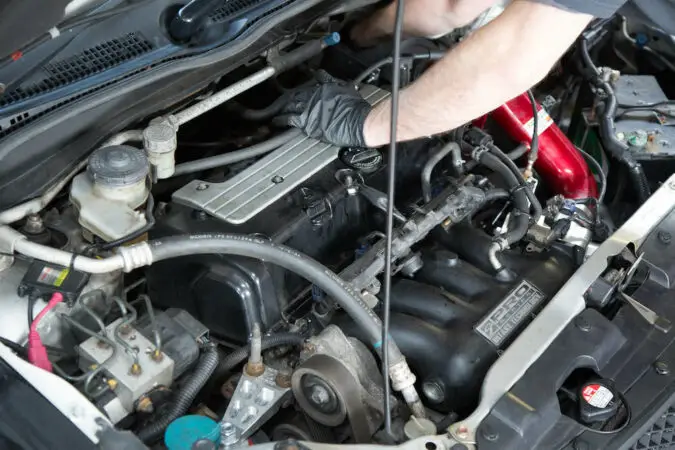The EGR valve is not a car part that we talk about often. But in reality, it plays a big role in the engine operation and controlling emissions. If it goes bad, what are the bad EGR valve symptoms you should look out for?
That’s what we’re going to discuss in this post and everything else that you need to know about the EGR valve, including repair costs. Here’s a table of contents to help you find the information you need:
What’s An EGR Valve?
Just in case you’re not familiar with the EGR valve, we’re going to discuss what it’s for and how it works. If you’re already familiar, then you can skip this section.
EGR valve stands for Exhaust Gas Recirculation valve. As the name suggests, the EGR valve allows exhaust gases to recirculate back into the engine.
The EGR is an emissions control device. Rather than allowing all of the exhaust gases to escape, some of it is recirculated through the EGR valve and mixed with air from the throttle body. It then enters the cylinders through the intake manifold along with fresh air.
The resulting air mixture has less oxygen, and this lowers the combustion temperature. The main effect of this is that it reduces Nitrous Oxide (NOx) gases from the engine, which is great for diesel engines since they produce a lot of NOx gases.
This system can also reduce fuel consumption. The exhaust gas occupies cylinder space, which virtually makes the engine a smaller displacement momentarily. This results in less fuel entering the engine, reducing fuel consumption.
The EGR valve normally opens when the car is idling, at low speeds, or decelerating. During these three conditions, the engine doesn’t need a lot of power and therefore it doesn’t need a lot of oxygen. The EGR opens to reduce the oxygen, combustion temperature, and emissions all at the same time.
EGR Valve Location
The EGR valve location varies depending on the car’s make and model. To help you find it, locate the engine’s exhaust manifold. It should have a pipe or a line that runs out of it; that’s the EGR system’s line.
Follow that line to find the EGR valve. The valve has a circle-shaped metal housing on top and a cylindrical body with two connections. It kind of looks like a tall mushroom when you hold it upright.
Some cars will require you to remove the engine plastic cover before you can access it. Best to consult with your service manual if you’re having difficulties finding it.
Bad EGR Valve Symptoms
Since the EGR valve plays an important role in both emissions control and engine operation (to find out more, check out our guide on what is the catalytic converter), you’re bound to experience some symptoms when they fail. Here are the bad EGR valve symptoms you should look out for:
1. Engine Performance Issues
First of the bad EGR valve symptoms is engine performance issues, and they can manifest in several ways. First, you may notice the car is slow to accelerate and feels like there’s a power reduction.
This usually happens when the EGR valve is stuck open, and the engine can’t adjust the fuel and air mixture to compensate. If the fuel and air mixture isn’t correct, then the engine can’t run at optimum power.
It can also result in a rough idle. Most cars usually idle between 600 to 800rpm at operating temperature, and it should remain stable at that RPM. If the needle jumps around while idling, that’s what we call a rough idle and a bad EGR valve can also cause that.
If the problem is severe, it may result in the engine stalling altogether. In this case, stalling happens either due to the engine not getting enough fuel or air, which could happen due to a bad EGR valve.
The bottom line is that a bad EGR valve can ruin the air and fuel mixture in the car. If the Engine Control Unit (ECU) can’t compensate for this, then it will result in performance issues.
2. Fuel Smell And Increase In Fuel Consumption
A bad EGR valve can cause the engine to use more fuel. This usually happens when the EGR valve is stuck open. This scenario reduces oxygen greatly since exhaust gases are constantly mixing with fresh air.
When there’s not enough oxygen, most cars are programmed to inject more fuel to keep the engine running. But your engine can only take so much, and too much fuel will result in unburnt fuel leaving the engine. This can result in a fuel smell inside the car.
Additionally, you might notice that your engine is using more fuel. Although this might be difficult to notice unless your car has an MPG indicator. In any case, fuel vapors are dangerous for your health. If you smell fuel inside the car you should address it immediately.
3. Overheating Engine
As mentioned, introducing exhaust gas to the air intake reduces the oxygen inside the engine and results in a lower operating temperature. If the EGR valve is faulty, this can affect the engine’s operating temperature.
This usually happens when the EGR valve is stuck closed and/or the EGR cooler fails. If the EGR is stuck closed, then the engine can’t reduce the oxygen level in the combustion chamber. This results in a higher combustion temperature, resulting in overheating.
The EGR also has a cooler to reduce the temperature of the exhaust gases. This helps to further reduce combustion temperature, and ultimately, reduce emissions. If the cooler fails, then the exhaust gas will mix with air at a higher temperature, resulting in an overheating engine.
A side effect of this overheating is usually engine knocking noise. This knocking noise happens when there’s pre-detonation of the fuel and air mixture, caused by intake air temperature that’s too high.
Of course, there are tons of possibilities why your engine is overheating. Unless other symptoms in this list accompany it, you might have a cooling system problem instead. Read our guide to overheating engines to learn more.
4. Emissions Test Failure
Since the EGR is an emissions control device, you’re bound to see an increase in your car’s emissions if it’s faulty. Of course, you won’t notice this in day-to-day driving. But if it happens to fail when you’re about to do your emissions test, then your car might not pass.
5. Check Engine Light
The check engine light turns on when the ECU detects an issue that it cannot fix. Your car is full of sensors that feed all sorts of information to the ECU. The ECU then uses that information to control various things, such as airflow, fuel injection, and ignition timing amongst other things.
When the ECU gets an erroneous reading from one of the sensors, it will adjust certain things to try to rectify the problem. If the problem persists, then it will register a Diagnostic Trouble Code (DTC) in the car’s On-Board Diagnostic (OBD) system.
This will then trigger the check engine light—or other warning lights depending on the issue—to signal to the driver that something is wrong and you need to fix it. And yes, there are sensors for the EGR valve.
If the EGR valve isn’t functioning normally, the ECU will know and will trigger the check engine light. While we all dread that amber light coming on, it will help to diagnose the problem and makes the troubleshooting process a lot easier. This segues us into our next topic:
Bad EGR Valve Symptoms: Causes And Diagnostic
An EGR valve usually fails simply due to age or because of carbon buildup. Like any other moving parts in your car, the valve can wear out over time and can become stuck. Preventing it from opening and closing properly. Most EGR valves usually last for about 10 years.
It can also fail due to carbon deposits. Unburnt carbon deposits can clog the valve, causing it to get stuck. It can also reduce the flow of exhaust gases back into the engine, causing the symptoms we mentioned above.
If you see bad EGR valve symptoms, here’s what you can do to troubleshoot it:
1. Scan For Trouble Codes
The first thing we want to do is scan for trouble codes in the car’s OBD system. This will let you know if the EGR is faulty, or if it’s something else causing the symptoms.
You’ll need an OBD scanner to do this. If your car was made after 1996, then it has an OBD-2 system and any OBD-2 scanner will work just fine since the system is universal.
You can get a cheap one like the Motopower MP69033 which will do the job just fine. Or if you feel like splurging, a professional-grade scanner like Autel MaxiCOM MK808 is great but costs nearly $500.
If your car has an OBD-1 system, then you’ll need to research how to diagnose your specific car make and model. If you have an OBD-2 system, here’s how to use the scanner:
- Locate your car’s OBD port. It’s usually behind a plastic panel under the dashboard on the driver’s side. Check your service manual if you can’t find it.
- Plug the scanner into the OBD port and turn on the car’s ignition.
- Scan for trouble codes. Some scanners may require you to input the car’s make and model, and VIN.
Codes P0400 to P0409 all indicate an issue with the EGR valve. P0400 and P0401 signal the EGR valve is clogged, while P0402 signals that the EGR valve won’t close. Meanwhile, codes P0403 to P0409 indicate an electrical issue with the EGR valve.
In any case, you’re going to want to test the EGR at this point. There are two major types of EGR; a vacuum controlled and an electronic EGR valve. The testing method will be different, so check with your service manual to find out the EGR type in your car.
2. Testing Vacuum Controlled EGR Valve
This test work best for the vacuum-type EGR valve. If you have an electronic vacuum-controlled EGR valve or a fully digital EGR valve, best to skip to the next section. Otherwise, here’s what you need to do:
- Locate the EGR valve and visually inspect it first. If there’s any physical damage to the housing, then you’ll need to replace it.
- If not, remove the EGR valve from the engine. You’ll need to undo a couple of bolts and disconnect some lines to remove it.
- After removing it, connect a hand vacuum pump to the EGR valve.
- Pull the pump’s trigger several times and pay attention to the gauge. If the vacuum doesn’t hold, you have a bad pump. But you also do a water test
- Put water in the EGR valve, then connect the pump once again. If the water escapes immediately, you have an EGR valve that’s stuck open and you’ll need to replace it.
- If not, connect the vacuum pump once again.
- Pull the trigger, and fluid should escape the valve. If it doesn’t, the valve is stuck closed and you’ll need to replace it.
We recommend watching the video above. It’s a great visual guide and will help you to test out the EGR valve. If your EGR valve doesn’t operate as it should, then it’s time to replace it.
3. Testing Electronic EGR Valve
If you have an electronically controlled EGR valve, you’ll need to test it by using a multimeter. Since it’s electronically controlled, you’ll want to test if the valve and its electrical connection are operating correctly.
This process gets a bit tricky, so you should watch the video for a complete explanation and guide. All you need is a multimeter, and follow the steps above and you should be able to diagnose it.
If you can’t quite pinpoint the problem, then it’s time to take your car to a trusted auto repair shop and have them diagnose the problem for you. Most repair shops charge around $120 for a diagnosis job.
EGR Valve Cost
If you need to replace the EGR valve, then you’ll need to prepare up to $350. An EGR valve replacement job will cost between $250 and $350 on average for most cars.
Around $170 to $270 of that will go into the EGR valve itself. And the labor cost is usually around $80 to $120 depending on local labor rates. Your car’s make and model will also affect labor, as it can be more difficult to remove the EGR valve in some cars.
Note that in some cases you may need to replace the cooler, and not the valve itself. The cooler will usually last for about 80,000 miles, so the lifespan is a little shorter than the valve.
Replacing the cooler is much more expensive. Some owners report that the cooler itself costs over $900 to replace, and the job can take up to six hours which means labor can be anywhere between $400 and $600 depending on labor rates.
It’s not uncommon to see stories in owner forums saying that they had to pay between $1,500 and $2,000 to replace the cooler. We won’t get into that though as we’re focusing on the EGR valve. But you can learn more about how to replace it here.
EGR Valve Cleaner
You may be able to fix your problem by simply cleaning your EGR valve. This is usually the case for an EGR valve that won’t open, and you can clean it by using a carburetor spray.
Keep in mind you’ll still need to take off the valve from the engine, then reinstall it back. And there’s no guarantee it will work again, so you might need to replace it anyway. But if you want to give it a try, here’s how:
- Remove the EGR valve.
- Wear safety goggles and gloves to protect yourself from the carb cleaner splashes.
- Spray the connections on the bottom part of the EGR valve with a carb cleaner. DO NOT spray the top part of the vacuum connection. It’s a good idea to wrap the top part with a small plastic bag.
- Let the fluid sit for about 10 minutes, and then flip the valve upside down. Use a soft brush to clean the carbon deposits if necessary.
- Reinstall the EGR valve back into the engine and see if it runs fine now.
If the EGR still isn’t working properly, then it’s time to replace it.
EGR Valve Replacement
Replacing the EGR valve yourself can save you a bit of money in labor costs. Here are the steps:
- Disconnect all the lines that connect to the EGR valve.
- Remove the bolts holding down the EGR valve, and then you can slide the EGR valve out.
- Prepare the new EGR valve. Some cars may have a gasket for the valve that sits on the engine. If the old gasket still looks fine (i.e. no damage whatsoever), then you leave it in place and reuse it.
- If not, then remove the old gasket and install the new one. The replacement valve should come with a gasket.
- Hand tighten the bolts, and then tighten them to about 25 ft-lb of torque. If you can’t fit a torque wrench, then make sure not to overtighten the bolts.
- If you had OBD trouble codes, clear them and this will reset the check engine light (which helps if you’re learning how to reset a BMW check engine light).
- Drive the car for about 15 minutes, and if the check engine light and symptoms don’t return, you’re good to go.
Watch the video above to get an idea of how to clean and replace your car’s EGR valve. The process is largely the same as long as you have a vacuum-controlled or electronic vacuum-controlled valve. As for fully digital ones, the steps should also be similar but will usually involve disconnecting some electrical connections.
Although the location will differ depending on your car’s make and model, the process is pretty much the same and you can use the video above as a reference. Good luck!
Facts on Bad EGR Valve Symptoms and Troubleshooting:
- Symptoms of a bad EGR valve include rough idling, increased fuel consumption, failed smog test, and a Check Engine Light on.
- A misfire may also occur due to clogged passages in the intake manifold caused by carbon buildup from exhaust gases flowing through the EGR valve.
- There are two kinds of bad EGR valves with different symptoms: a valve stuck open or a valve stuck shut.
- Troubleshooting should be done before replacing parts, as the same engine performance problems can indicate problems in other parts of the system such as spark plugs, fuel filter, and engine sensors.
- Troubleshooting procedures for vacuum and electrical vacuum-controlled EGR valves can be found in the article “How to Test an EGR Valve.”
- Electronic EGR valves are easier to troubleshoot with the help of an aftermarket scan tool.
- Common DTCs related to the EGR system or valve include P0400, P0401, and P0402.
- The EGR valve allows the flow of exhaust gases into the intake manifold in controlled amounts, reducing the formation of NOx gases that cause air pollution and health problems.
- Types of EGR systems include older vacuum-controlled EGR valves, electronic-vacuum EGR valves, and newer electronic EGR systems with additional components.
- Troubleshooting should include identifying the type of symptoms a troubled EGR valve will produce and testing the valve and other components to narrow down the problem.
Bad EGR Valve Symptoms FAQ
We get quite a lot of questions about the EGR valve, so here are some quick answers:
What Is An EGR Valve
An EGR (Exhaust Gas Recirculation) valve is a valve that opens to allow exhaust gases to recirculate back into the engine. Its purpose is to reduce emissions—especially NOx gases—by reducing engine temperature.
What Does An EGR Valve Do
An EGR valve recirculates exhaust gases back into the engine. This reduces the amount of oxygen in the engine, which then lowers the combustion temperature. This ultimately reduces the emissions that the engine produces. Essentially, it’s an emissions control device.
What Does EGR Stand For
EGR stands for Exhaust Gas Recirculation.
How To Test EGR Valve
If you have a vacuum-operated EGR valve, you can test it by taking it out and then attaching a hand vacuum pump to its vacuum connection. Pull the trigger, and if the gauge doesn’t hold, then the valve is faulty. Afterward, you should test it by inserting water into the bottom connection. If it leaks out immediately, then it’s bad. If it doesn’t, then use the vacuum pump again. Water should escape the valve when you pull the trigger. For fully electronic EGR, you’ll need to test it with either a multimeter or a professional OBD scanner capable of performing a test.
Where Is The EGR Valve Located
The location varies depending on the car’s make and model. You can locate it by finding a pipe or a line that comes out of your car’s exhaust manifold. And then follow that line to find the EGR valve, which usually has a circle diaphragm and a cylindrical body that connects to the engine. It kind of looks like a tall mushroom when you hold it upright.
What Damage Can A Faulty EGR Valve Cause
The damage will cause depends on the symptoms it produces, which can vary depending on whether the EGR is stuck open or closed. But some potential damage includes internal engine damage due to overheating, and a shorter catalytic converter lifespan because of increased emissions.
What Are The Symptoms To A Bad EGR Valve
Bad EGR valve symptoms include rough idling, reduced engine performance, fuel smell inside the car, overheating engine, and a check engine light.
Bad EGR Valve Symptoms: Final Thoughts
To summarize, the EGR valve is part of your car’s emissions system. Its purpose is to allow exhaust gas to circle back into the engine, which reduces oxygen in the combustion chamber. This results in a lower combustion temperature, which reduces the overall emissions that the car produces.
You should replace a bad EGR valve immediately before it turns more serious. While immediate damage is rare, it can cause severe damage in the long run which can cost thousands of dollars to repair.
Replacing the EGR valve is quite easy, so you might be able to do it yourself. But the valve can be difficult to reach in some cars. If you’re not comfortable with replacing it yourself, then you should have a professional do it for you. It should take them no more than three hours to do the job. Good luck!






